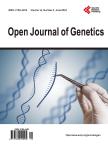HLA-G 3’UTR 14 bp Insertion Is Associated with a Decreased Risk of Developing Human African Trypanosomiasis in the Côte d’Ivoire Population
HLA-G 3’UTR 14 bp Insertion Is Associated with a Decreased Risk of Developing Human African Trypanosomiasis in the Côte d’Ivoire Population作者机构:Felix Houphouet Boigny University (UFHB) Cocody Abidjan Cô te d’Ivoire Jean Lorougnon Guédé University (UJLoG) Daloa Cô te d’Ivoire Institut de Recherche pour le Développement (IRD) Mère et Enfant face aux Infections Tropicales Faculté de Pharmacie Université Paris Descartes Sorbonne Paris Cité France Centre International de Recherche-Développement sur l’Elevage en Zone Subhumide (CIRDES) Bobo-Dioulasso Burkina Faso Programme National d’élimination de la Trypanosomiase Humaine Africaine Abidjan Cô te d’Ivoire School of Veterinary Medicine Makerere University Kampala Uganda Institut de Recherche pour le Développement (IRD) IRD-CIRAD 177 Intertryp Université de Montpellier Montpellier France Institut Pierre Richet Bouaké Cô te d’Ivoire
出 版 物:《Open Journal of Genetics》 (遗传学期刊(英文))
年 卷 期:2019年第9卷第2期
页 面:31-41页
学科分类:1002[医学-临床医学] 100214[医学-肿瘤学] 10[医学]
主 题:HLA-G Human African Trypanosomiasis Trypanosoma brucei gambiense Genetic Association Study
摘 要:Human African trypanosomiasis (HAT), or sleeping sickness, caused by Trypanosoma brucei gambiense, is associated with diverse clinical outcomes. Host’s genetic factors involved in immunity are potential factors that can regulate infection. Genetic polymorphisms within HLA-G could influence the level of HLA-G expression and therefore play a critical role in infection outcomes. The goal of our study was to investigate the association of 14 bp Indel HLA-G polymorphism with the susceptibility/resistance to HAT. DNA samples were collected from 119 cases, 221 controls and 43 seropositive individuals living in Ivorian HAT foci. The 14 bp Indel polymorphism was determined by PCR. Homozygous individuals for 14 bp insertion had a lower risk of progressing to active HAT (p = 0.012, OR = 0.27, 95% CI: 0.09 - 0.8). Moreover, the frequency of 14 bp insertion homozygous genotype was higher in the seropositive group (11%) than in the HAT cases group (3%) (p = 0.043, OR = 0.27, 95% CI: 0.07 - 0.99), which suggested a protective effect of 14 bp insertion homozygous genotype. Genetic polymorphisms in HLA-G may be associated with a variable risk to develop HAT. The 14 bp insertion appears to favour the occurrence of long-lasting T. b. gambiense latent infections.



